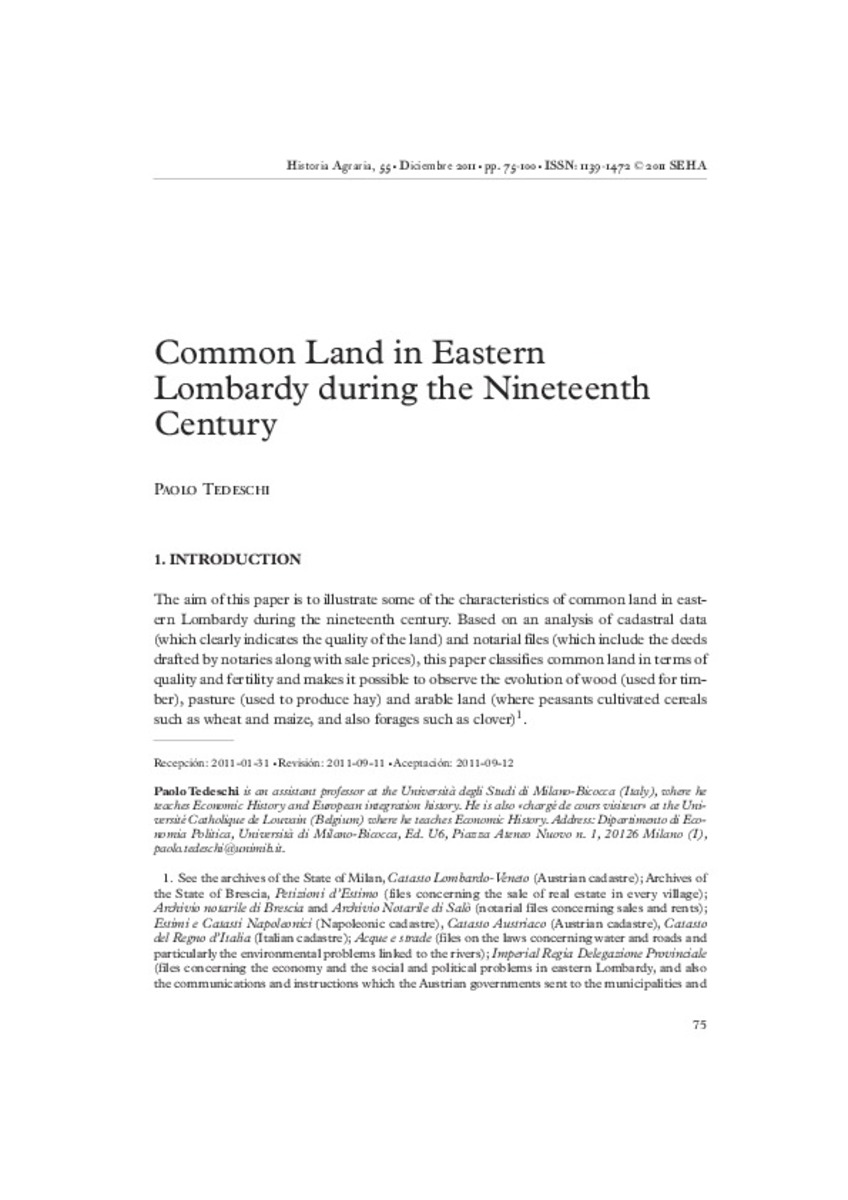Mostrar el registro sencillo del ítem
Common Land in Eastern Lombardy during the Nineteenth Century.
| dc.contributor.author | Tedeschi, Paolo | |
| dc.date.accessioned | 2016-02-12T09:54:44Z | |
| dc.date.available | 2016-02-12T09:54:44Z | |
| dc.date.issued | 2011-12 | |
| dc.identifier.issn | 1139-1472 | |
| dc.identifier.uri | http://hdl.handle.net/10234/149669 | |
| dc.description.abstract | Este texto presente las características de las tierras comunales en Lombardía oriental durante el siglo XIX. Analiza los métodos empleados para maximizar los ingresos obtenidos del comunal y el sistemaempleado para distribuir los productos cosechados.Además pone de relieve los daños medioambientales ocasionados por la población (colonos o propietarios) que no utilizaba el comunal en los valles alpinos. Los gobiernos favorecieron la venta de los comunales, pero tendieron a subestimar la inversión que debían afrontar los nuevos propietarios para mejorar los suelos. El resultado fue que las leyes desamortizadoras produjeron una sobreexplotación de las tierras comunales: en su mayor parte fueron vendidas pero el objetivo principal de los municipios y el Estado generar ingresos a través de las ventas y del aumento de los rendimientos no se alcanzá. En algunos pueblos los costes sociales y económicos de las ventas fueron altos (entre el 50% y el 80% de los habitantes se vieron obligados a emigrar) y, en la medida en que los nuevos propietarios sobreexplotaron los antiguos comunales, se causó un perjuicio ecológico. Muchos problemas se derivaron del uso inapropiado de los comunales: los nuevos propietarios intentaron recuperar rápidamente las inversiones con costes elevados para los suelos. únicamente el progreso técnico (aumento de rendimientos) y la nueva legislación que limitó el poder de los propietarios pudieron restaurar la situación. Si consideramos cómo los comunales y la distribución del producto redujeron los riesgos medioambientales y ayudaron a mucha gente a sobrevivir, podemos concluir que el uso colectivo de la propiedad era menos caro que la propiedad privada. Esto es mucho más evidente en los altos valles alpinos y allá donde los ingresos medios eran bajos y las inversiones necesarias para aumentar los rendimientos, muy altas. | ca_CA |
| dc.description.abstract | The paper presents the features of common land in eastern Lombardy during the nineteenth century. It analyses the methods used to maximise earnings derived from common land and the system used for the distribution of the products which were obtained. Furthermore it evaluates the damage caused to the environment by the people (whether tenants or owners) who did not use common land in the Alpine valleys as a whole. Governments favoured the sale of common land, but they underestimated the investment required by new landlords to make real improvement in plots of land. The result was that new laws contributed to an over‐exploitation of common land: most of the common land was sold but the principal goal of municipalities and governments (to generate revenue through sales and increased yields) was not been achieved. In some villages the social and economic costs were very high (between 50% and 80% of inhabitants were forced to emigrate) and, as new landlords over‐exploited previously common land, there was some environmental damage. Many problems were related to the inappropriate use of common lands: new landlords adopted a strategy aiming at a rapid pay‐off for their investment which simultaneously created environmental dangers. Only technical progress (improving yields) and new laws limiting the power of landlords could restore the situation. If we consider how common land and the system of distribution of its produce reduced environmental risks and helped people to survive, it becomes clear that the collective use of property was less expensive than private ownership. This was more evident in the high Alpine valleys and where the average earnings were low and the investments needed to increase yields were very expensive. | ca_CA |
| dc.format.extent | 26 p. | ca_CA |
| dc.format.mimetype | application/pdf | ca_CA |
| dc.language.iso | eng | ca_CA |
| dc.publisher | Sociedad Española de Historia Agraria (SEHA) | ca_CA |
| dc.relation.isPartOf | Historia agraria: Revista de agricultura e historia rural, nº 55, pp. 75-100 | ca_CA |
| dc.rights | © 2011 SEHA | ca_CA |
| dc.rights.uri | http://rightsstatements.org/vocab/InC/1.0/ | * |
| dc.subject | Italia del norte | ca_CA |
| dc.subject | siglo XIX | ca_CA |
| dc.subject | comunales | ca_CA |
| dc.subject | agricultura | ca_CA |
| dc.subject | mercado de la tierra | ca_CA |
| dc.subject | common Land, | ca_CA |
| dc.subject | northern Italy | ca_CA |
| dc.subject | 19th century | ca_CA |
| dc.subject | common land | ca_CA |
| dc.subject | agriculture | ca_CA |
| dc.subject | land market | ca_CA |
| dc.title | Common Land in Eastern Lombardy during the Nineteenth Century. | ca_CA |
| dc.type | info:eu-repo/semantics/article | ca_CA |
| dc.subject.jel | N53 | ca_CA |
| dc.subject.jel | P14 | ca_CA |
| dc.subject.jel | Q15 | ca_CA |
| dc.subject.jel | Q23 | ca_CA |
| dc.rights.accessRights | info:eu-repo/semantics/openAccess | ca_CA |
| dc.relation.publisherVersion | http://historiaagraria.com/info_articulo.php?id=569 | ca_CA |







